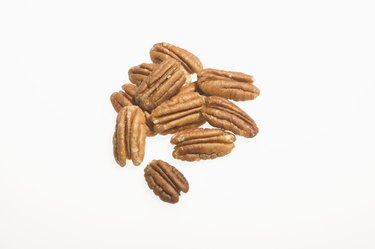
Kentucky has no scarcity of nut-bearing trees. Several species occur throughout the entire state, according to the "National Audubon Society Field Guide to Trees." Among them are the butternut, black walnut and many types of hickories, including the pecan tree. The key to identifying these nut-bearing Kentucky species is to look for specific features on each tree, with very close attention being paid to the leaves and the nuts.
Step 1
Recognize the pecan tree by its height and by its leaf structure. The pecan can grow to heights in the 100 to 150 foot range. The tree only grows in the wild in western Kentucky, but cultivated forms occur throughout the state. Look at the compound leaves of the pecan and notice they are compound. The leaf consists of one long central axis stem (rachis), to which a variable number of leaflets attach by short stalks to form one leaf. Pecan leaves have from 11 to 17 leaflets, with the leaflet having a slightly curved look and possessing fine serrated teeth on its edge. The pecan nut comes in an oblong brownish husk.
Video of the Day
Step 2
Look at the many leaflets on a black walnut leaf to help you identify this Kentucky nut-bearing species. Each leaf contains about 16 separate leaflets, notes the University of Kentucky site. The nuts have a thickened green husk around them. Notice that when you handle the nuts, a brown-yellow dye will seep out and stain your hands. Black walnut trees can be as high as 100 feet, but most mature walnuts in Kentucky top out at about 60 feet tall.
Step 3
Observe the form of the butternut trees in Kentucky. Butternuts have a short straight tree trunk and stout lower branches. Butternuts can grow to 70 feet in height and have leaves with from 11 to 17 leaflets. Examine the nuts growing in clusters of as many as five. You will see they are egg-shaped with pointed ends and that the nut inside the husk is very oily.
Step 4
Identify the Kentucky hickory trees by their bark. Study the bark of the shellbark and shagbark hickories and look for thin, narrowed scales of bark with outward curving ends all over the trunk. Inspect the bark of the bitternut hickory, looking for gray bark with shallow furrows. Pignut bark is smoother than most Kentucky hickories, while mockernut hickory bark is grayish and features shallow ridges and furrows.
Step 5
You can distinguish the Kentucky hickories by the size of their leaf rachis and the number of leaflets they have. Shagbark hickory has a rachis as long as 14 inches and typically has five leaflets on one leaf. Shellbark hickory leaves can be 24 inches in length, with the usual number of leaflets being seven. Mockernut hickory has a leaf as long as 1 foot, with from seven to nine leaflets attached to it. Pignut hickory has a 6 to 12 inch long rachis and normally has five leaflets per leaf. Bitternut hickory has a 6 to 9 inch rachis, reports "Trees of North America," with from seven to eleven individual leaflets on it.
Video of the Day